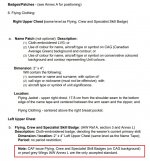Actually, in this case, I think the new metal wings/badges are worth the time/effort.
War-era bomber to be part of new RCAF flying badges
More than 63 years ago, eight airmen from 426 Squadron–seven from the Royal Canadian Air Force and one from the Royal Air Force–set off on a bombing raid against the railyards in Louvain, Belgium.
They, and the Halifax bomber in which they were flying, never returned.
Halifax bomber LW682 was shot down on May 13, 1944, near the village of Geraardsbergen, Belgium, and crashed in a bog. The Germans recovered and buried five of the dead, but three airmen remained entombed in their aircraft. That is, until September 1997, when a small group of dedicated Canadian volunteers, led by Karl Kjarsgaard of the Halifax Aircraft Association, and the pilot’s nephew, Jay Hammond, began the work of recovering LW682, which was buried in up to seven metres of mud.
When the shattered aircraft was recovered, the three remaining aircrew–PO Bentz; PO Summerhayes and PO Fred Roach-were still at their stations. They were buried with full military honours in Belgium in November 1997, alongside their five comrades.
On June 28, 2017, the commander of the Royal Canadian Air Force, LGen Mike Hood, accepted eight ingots of aluminum that had been cast from the melted down wreckage of LW682. Their destiny? At least two of them will become a tangible reminder of RCAF history and heritage, worn by members of RCAF aircrew.
Several years ago, the RCAF moved from gold-coloured accoutrements (rank insignia, buttons and so on) to their traditional colour of pearl grey or silver. The RCAF’s flying and occupation badges (wings) are now being recreated in a silver colour.
As part of this process, each set metal “full wing” flying badges worn by pilots, air combat systems operators [sic], loadmasters, search and rescue technicians, airborne electronic sensor operators and flight engineers will incorporate a portion of aluminum from LW682.
The aluminum from LW682 will also be incorporated in the new metal “upswept wing” flying badges worn by personnel with the following specialist flying qualifications: flight crew, flight test engineer, flight surgeon, aeromedical evacuation, tactical helicopter observer and airborne warning control.
“It’s my intent . . . to use some of this metal from the 426 Halifax and put it in the new wings we’re creating for the Royal Canadian Air Force,” explained Hood. “You can see that our previous wings were gold in nature and we’re going back to our roots and recreating them in silver. So our wings will be silver and all of them will contain a certain amount of this great donation.”
James Blondeau presented the ingots to the commander from Halifax 57 Rescue (Canada) and the Bomber Command Museum (in Nanton, Alta.) on behalf of Kjarsgaard. As well as being incorporated into the wings, some of the aluminum will be used for other memorial and commemorative purposes
“These ingots represent a large part of our history in our Air Force,” continued Hood. “They represent an aircraft that most of the Canadians in Bomber Command would have flown and . . . I see in these ingots the lives and the sacrifice and the commitment of all those airmen and airwomen who came before me.”
The method of incorporating the aluminum in the new silver coloured wings is being finalized, with production and distribution timelines to be determined.
This is not the first time aluminum from LW682 has been put to good use. The roof of the Bomber Command Memorial in London, England, unveiled by Queen Elizabeth II on June 28, 2012, is constructed from LW682 aluminum. In September 2012, Prince Edward, Earl of Wessex, unveiled a memorial to the crew of LW682 at 8 Wing Trenton, Ont. Polished ingots, each engraved with the name of a crew member, are embedded in a memorial wall at the Air Mobility Training Centre.
In October 2013, a memorial commemorating 16 citizens of Virginia, U.S., who served in the RCAF during the Second World War was unveiled in Richmond, Va. The war-era RCAF badge and the Virginia state insignia, incorporated into the memorial, are cast from LW682 aluminum.
“We have about 800 pounds [of aluminum from LW682] left,” noted Blondeau during the presentation. The remaining ingots are stored securely at the Bomber Command Museum in Nanton.
IIRC, the Door Gunner badge was created/approved after this article but I would guess they too will also include some of the aluminum from LW682.
The last update on the metal badges was
CANFORGEN 152/18 - RCAF DEU FLYING AND OCCUPATION BADGE DISTRIBUTION ADVISORY, but the last time I enquired at Wing Clothing they told me "no word on the delivery yet" (that was around Jan/Feb maybe?).




